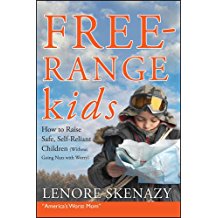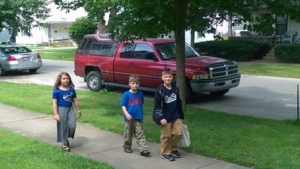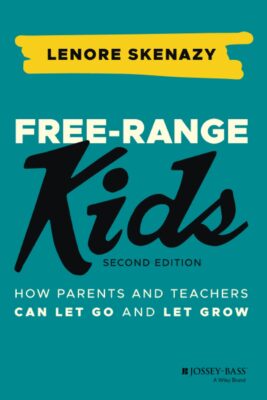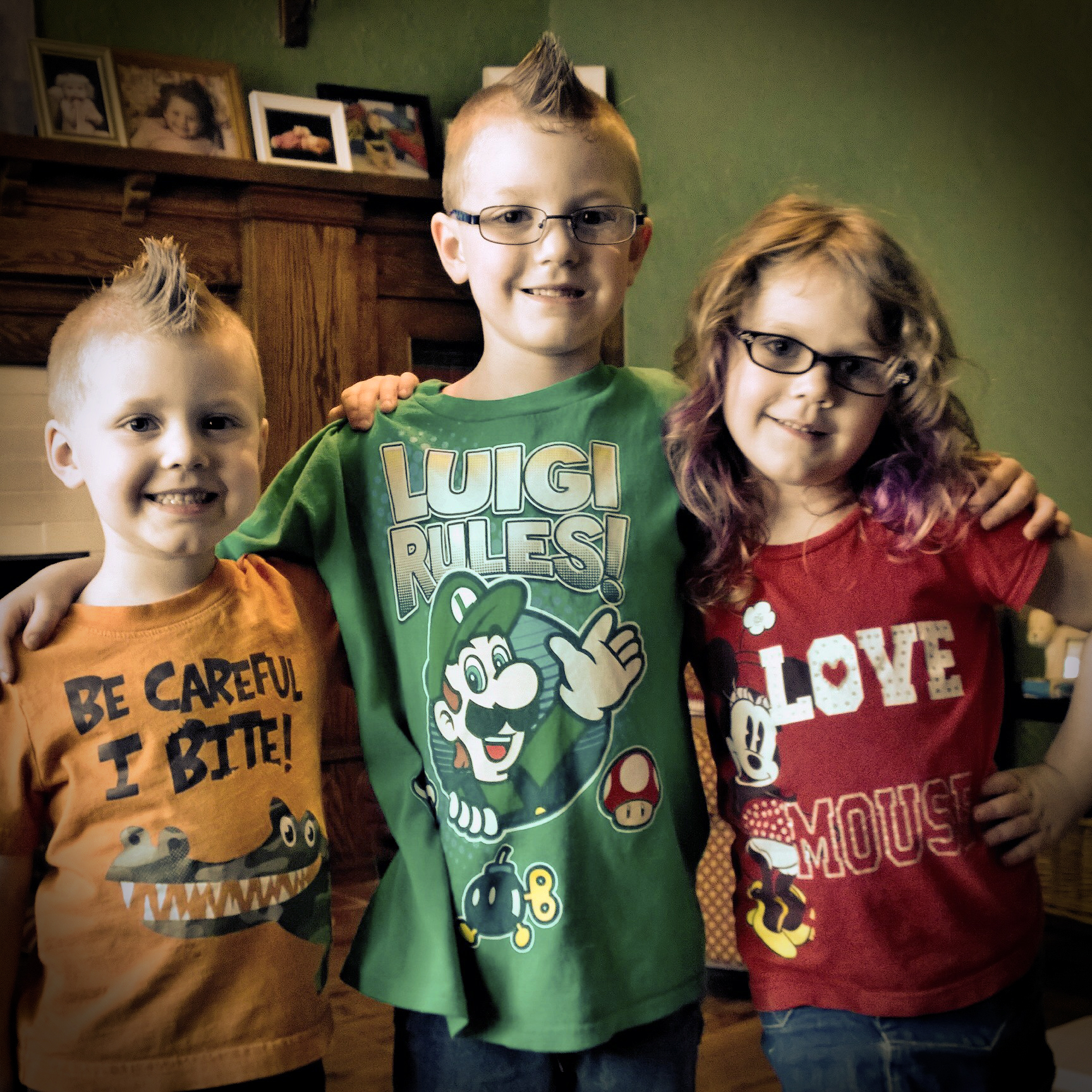Free-Range Kids
2024 UPDATE – After 7 years and a tragic event in my area, read my update at the end of this post
Free-Range Kids… is it for you?
 While walking out of the library the other day, a book titled Free-Range Kids by Lenore Skenazy, caught my eye and I grabbed it. I don’t know this author and reading a book like this is a bit unusual, but it piqued my interest.
While walking out of the library the other day, a book titled Free-Range Kids by Lenore Skenazy, caught my eye and I grabbed it. I don’t know this author and reading a book like this is a bit unusual, but it piqued my interest.
Honestly, I am glad I saw this book.
Most moms today are very hesitant to allow their kids to walk to the corner store by themselves, ride their bikes around the block by themselves, or head to the park by themselves, and I wasn’t any different. I mean, how often do we hear about an Amber Alert or even get a notification of one? It is enough to make parents panic!
What are the Facts?
How can we not be in fear when we hear the details of those cases that make the media, knowing that many don’t? With the increased “around the clock” media we now perpetually worry about child abduction and so we have decided that the outside is not an ok place for our children, but is that really true? What are the facts?
While we often say missing children, it should be noted that missing children and abducted children can mean different things. Children can run away from home or get lost and become missing children. Child abduction is something different, here a child has actually been taken by someone and is also missing.
The Department of Justice states that about 460,000 children go missing every year in the United States, but the minimum requirement to be considered a missing child is the following…
- the person needs to be under 18 or considered in the category of Critical Young Adult (age 18-20)
- they need to be missing from their parent, guardian, or caretaker for one hour
This means some of those 460,000 are simply children who went to a neighbor’s house, their parents couldn’t find them, understandably panicked, and called the police.
The DOJ has also stated that out of the 460,000 missing children, only 105 of them are stereotypical kidnappings. In fact, according to Missingkids.org, the breakdown of the 460,000 missing children looks like…
- 90.7% Runaways
- 4% Family Abductions
- 4% Critically Missing Young Adults (ages 18-20 and are on the list due to a situation or special need of individual)
- 1% Lost, Injured, or Otherwise Missing
- 0.3% Non-Family or Stranger Abduction
However, when children do go missing the media reports the phrase 460,000 missing children, and this causes the average American to wonder if there is an increase in child abductions.
The answer is… there is not!
The FBI has reported that missing children’s cases have fallen 40% in the years between 1997-2014 and studies that are coming out show that it is continuing to fall. In fact, general crime rates are much lower than they were in the 70s, 80s, and 90s, and while we often think of small children being abducted, the most common victims are ages 12-17.
Sadly, these facts show that crimes against children do exist and as parents (or everyone because it takes a village) we need to be aware of that, however, these facts also show that crimes against children are nowhere near as common as they are being reported.
One crime against one child is one too many! These numbers are not meant to say that crimes against children do not happen because they do, but they are meant to show that it is not the epidemic that is being reported.
Reading Free Range Kids
Honestly until very recently, I was too scared to even let my kids play outside in our front yard by themselves. The thought of letting my children enjoy the childhood I had, one where I rode my bike everywhere by myself, walked to our local corner store for candy and played around the neighborhood for hours by myself, was a terrifying thought. It seemed I was not alone in this, all moms that I knew were like-minded, and so this was the norm, but I always had a little voice in the back of my mind that knew I was doing my kids a great injustice.
My goal is to raise kids who can handle themselves, who don’t need me for every little thing, and who feel safe in the real world, so when I found the book Free-Range Kids, I was excited to read it. The book goes into depth on why most parents are afraid based on myths and rarities that occur less than winning the lottery and getting struck by lightning… on the same day. I recommend every parent reading this book, even if the idea of having a child that has more freedom scares you, this book has some great information.
Of course, the book isn’t without controversy.
- The author, Lenore Skenazy, got a lot of flack for allowing her 9-year-old son to ride home on the New York subway alone, giving him just tokens and a map. Many called her irresponsible and even a “bad” parent, questioning her parenting advice.
- The book also fails to discuss that there are locations that are safer than others and that there is a big difference between a small rural city and some of the neighborhoods in Chicago.
- Being from the United States, this book is written through the eyes of an American author, which is something she has been criticized for.
It should be noted that parents need to use common sense. Walking to the corner store in my town versus Los Angeles could be a completely different scenario and the statistics of the United States are not the statistics of Columbia, Nigeria, Germany, or China (I just picked random countries). The author is merely stating that a generation of parents might be making decisions based on skewed information and tactical media coverage.
I also think the last point above is a bit ridiculous. While the author is American, it is clear she is writing about conditions in the United States. I would not expect a parent from France to write a book like this that would apply to the United States. If I read that book, which is a little niche (as is Free-range Kids) it might cause me to look into the statistics of my country… I would not expect a French author, writing about France, to cater to me.
What I Have Learned
- Free-Range children are children that can live life much like those of the 80s and earlier. They can ride their bikes around the neighborhoods and be able to experience some independence without constant parental supervision.
- I have learned that as a parent I need to realize dangers are present and real, however, I also learned that I need to do research and not get caught up in sensationalized media reporting.
- I now understand that my kids are capable of more than I thought and that they can be trusted to follow the rules my husband and I set.
- Children, like adults, learn through experiences and they need to be given a chance to live those experiences (within reason).
- I learned to talk to my kids about dangers without making them scared of the world around them.
- Most importantly, I have learned that having kids outdoors and unaccompanied doesn’t equate to being unsafe. This was a slow process and is still evolving.
Putting This New Way of Thinking Into Practice
My husband and I sat down with the kids, who are 7, 8, and 9, and explained the dangers… people driving too fast, people texting and driving, people acting weird or funny, and the like. They also know that rarely a child is taken and bad things do happen, we didn’t hide that point either.
We also went on to give a set of rules that had to be followed… staying together, crossing at the corners, NEVER going with someone they don’t know or that isn’t on the list of approved people, they are to always let us know where they are, and lastly… and this one might bring me some hate… but we let them know it is OK to talk to strangers.
Strangers aren’t bad, I see little old ladies talking to kids in the stores only to have those kids ignore them or say they can’t talk to strangers, and if something is wrong with your child, they might be afraid to get help because they don’t want to get in trouble for talking to a stranger. We instead explained that if they are in trouble, they should find a police/fireman, a parent, or even another kid to bring into the situation, this is of course if getting to us is, for some reason, out of the question. Truth is most people want to help and telling your child strangers are bad is closing them off from humanity.

After this talk, we allowed them to go to the park 1 block away, by themselves but together.
Then, we started allowing them to ride their bikes around a few blocks.
Next, they were able to walk to the corner store, which is 2 blocks and across Main St.
Since then, they have been allowed to walk to and from piano practice which is 3 blocks (the piano teacher and I text each other about departure and arrival), the city park which is 7 blocks, from martial arts practice which is 6 blocks (for longer trips they carry my phone), and in general are able to play in the neighborhood with their friends without a helicopter parent. The kids have even started walking the neighbor’s dogs for extra income and they do this by themselves for several blocks.
Do I worry… yes!
I let them walk home from martial arts for the first time just this week, and I was worried because the location is in the heart of our town (we have about 6000 people in our town). My worry didn’t come from not trusting them and honestly, after learning the statistics very little of my worry came from what could happen to them… my worry came from what other people would say.
What a ridiculous thing to worry about but parents today are very vocal with their judgment. I have read about a case of parents in Maryland who had issues with people calling the police on them for doing exactly what I was… letting their kids “free-range” and I was worried this would happen to me. I think some of this worry comes from the fact that I also homeschool, something many people consider odd to begin with. Of course, statistically speaking, that would be an extreme, rare event too but it still worries me from time to time.
Last Thoughts
Growing up in the 80s, I can appreciate the concept of free-range parenting as it is how I and my entire generation were raised. I have so many fond memories of running around with friends and it is a sad thought that generations are missing out on that!
As parents we worry, it is in our nature and I am not blind to the possibilities, but I have weighed them. Children have a 1 in 720,000 chance of being kidnapped but this small risk shouldn’t rob our children of the world. As parents and adults in general, we all need to make spaces and events safer. Be on the lookout more. Parents need to get to know their neighbors so they are no longer strangers. We need to allow children to grow into independent people and not live in fear.
We live in an imperfect world but in reading this book and doing some of my own research, I can give my children gifts. I now feel free to give them the gifts of freedom, choice, experience, and confidence.
I know that the idea of free-range children isn’t for everyone, but I highly recommend this book to all parents, if nothing else, for a different perspective.
BEM and Fam 🙂
UPDATE 4/11/2024
 Since the original blog post, Lenore Skenazy has published an expanded second edition of her book. This version seems geared toward parents and teachers versus just parents. Though published three years ago, I just found it and it is in my Amazon cart!
Since the original blog post, Lenore Skenazy has published an expanded second edition of her book. This version seems geared toward parents and teachers versus just parents. Though published three years ago, I just found it and it is in my Amazon cart!
Finding this book prompted me to think about the original blog post and update it. After 7 years of allowing my kids to “free-range” what is life like for my kids today?
My kids have been able to enjoy some of the freedoms that I loved having as a child. They’ve enjoyed riding their bikes to the city park and pool. For Christmas, their grandparents bought them each a longboard and the kids ride them to their Jiu-Jitsu lessons during warmer months. At 15, 14, and 13, they really have grown up enjoying a level of independence that many of their peers don’t have.
My children realized that to have this freedom they would need to be responsible. They were given rules and with almost no exception, they have been followed. I think it is because they were able to understand the importance.
While walking to a baseball game the mother of one of my son’s teammates stopped to offer the kids a ride. Though they knew her, they declined. She called me to tell me that the kids thanked her but were persistent in not going with her, even though she tried to convince them. She wanted me to know that I had done a good job! In a world of judgment, that was very nice to hear.
This doesn’t mean I haven’t had doubts.
Delphi Murders
In 2017, the same year I wrote the original blog post, two girls, Abigail Williams (13) and Liberty German (14), were murdered on a walking trail in the small town of Delphi, Indiana. Even though Delphi is less than an hour from my home, we didn’t hear much about this crime. In fact, this didn’t become news to my family until a couple of years later. This has to do with our local media being based closer to Michigan and the media coverage of Delphi being handled by another outlet counties away… and then Covid hit.
This crime is a sad one and I don’t want to go into many details, but it did have me think about the concept of free-ranging children. These girls were murdered while simply on a walk in a town a third of the size of mine (less than 3,000). It made me question, are children safe anywhere? Am I wrong for this approach?
While this crime was terrible, it still falls into the category of extremely rare. While updating this post and looking up new statistics (which I updated in the original post), crime against children is still on point with the original post. Though crime saw an uptick in 2020, crime in general is still down compared to the 70s, 80s, and 90s.
My heart breaks for these families and any family that sees crime toward a child, or anyone for that matter. Statistics don’t make families of missing children feel better and I understand that, but we can’t allow risk to keep us in an irrational panic.
Helping Our Children
Though the above had me question some choices, I realized that there are practical ways we can help our children.
- We can explain, in an age-appropriate way, that there are dangers in the world. We can not prepare children for a world that we hide from them.
- We need to let children know that they can follow their gut AND then listen to our children when they tell us that they don’t “like” someone. (This doesn’t mean they are bad but as parents, grandparents, teachers, and so on, we need to listen)
- We should get rid of “stranger danger” and let our children that strangers are not bad. Not only does this create issues while they are children, but it also sets up isolated habits as people age.
- Parents need to make good decisions, set clear boundaries, and be consistent with their children.
- Showing children how to speak out, get help, and defend themselves is a must.
- Getting to know neighbors, setting up a safety net within a community, and having a village to help can be great ways to create a safer community.
I think that by allowing my children to be able to have some independence and responsibility, I have helped them become more confident. In that regard, I still stand by allowing my children to “free-range”!
New Book
Once I read the new book above… I will update you with any thoughts! I am interested in the parts geared toward teachers. Though I don’t discuss it much, I teach children online and while it is different than in-person teaching, it has opened my eyes to the needs of teachers. I hope to see more parents and teachers working together to help kids succeed!
If you have read either book or have any comments, please share them below or head over to Instagram or Facebook. You can always tag or mention me @bemandfam and I’ll be notified!
BEM and Fam 🙂
PS. This post has some affiliate links, read more about those here.






